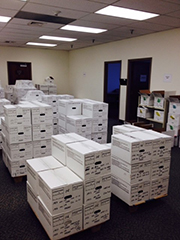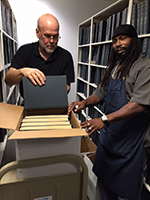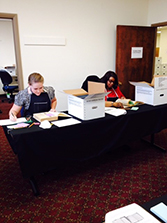The U.S. Government Publishing Office (GPO) continues to monitor the discussion of the Joint Steering Committee for the Development of RDA: Resource Description and Access. RDA is based on FRBR, or Functional Requirements for Bibliographic Records, and was released in 2010. It has undergone testing at the Library of Congress, the National Library of Medicine, the National Agricultural Library, and at RDA National Test Partner Libraries.
In June of 2011 several updates were released, which add further to this discussion. The links to the full text of the documentation are included here:
- Report and Recommendations of the U.S. RDA Test Coordinating Committee
- Executive Summary of the U.S. RDA Test Coordinating Committee
- Response of the Library of Congress, the National Agricultural Library, and the National Library of Medicine to the U.S. RDA Test Coordinating Committee
The transition to RDA is complex, but several changes are notable in how they differ from current AACR2 standards:
- RDA will impose new rules for the creation of added entries (elimination of the "rule of 3").
- Most abbreviations are to be eliminated, particularly Latin abbreviations.
- The general material designation (GMD) will be replaced by three new MARC fields: content type (336), media type (337), and carrier type (338).
- RDA will use mode of issuance instead of continuing resources.
- The impact of RDA on authorities. Much is still unknown about the impact of RDA and the hybrid environment in the national authority file, although a policy has been developed for PCC members on using RDA and AACR2 authority records.
The general recommendation of U.S. RDA Test Coordinating Committee regarding the timeline for completion has been revised, with a projected implementation date no earlier than January 2013.
Progress Updates
Update 10 (9/15/2015)
GPO successfully completed implementation of RDA in April 2013 and now catalogs new bibliographic and authority records according to the RDA standard. In FY15, GPO continued to monitor and apply new and updated practices in RDA, its Library of Congress Program for Cooperative Cataloging Policy Statements, and other documentation of the Program for Cooperative Cataloging (PCC). In addition, Library Technical Services continued to review, evaluate, update, and develop local practices and procedures. As a result, nine new GPO Cataloging Guidelines were published in September 2015. The full complement of remaining bibliographic GPO Cataloging Guidelines will be published in FY16. Finally, in FY15, Library Technical Services trained new staff in RDA practices, offered refresher training to existing staff, provided personal training and improved staff performance through ongoing quality assurance, and presented eight technical services webcasts and webinars to the public.
Future updates to GPO’s cataloging practices will be posted via the FDLP News & Events email services and on the FDLP home page.
Update 9 (2/12/2014)
The RDA Implementation Team’s quality control of Congressional titles revealed three issues that were addressed with modifications to GPO cataloging practice. Beginning in December 2013, GPO Bibliographic Control and Metadata librarians use the following practices for newly cataloged Congressional titles:
- The application of relationship designators germane to these document types, including enacting jurisdiction and jurisdiction governed.
Decision: GPO will apply enacting jurisdiction to the United States for public and private laws, statutes, and treaties.
Decision: Jurisdiction governed will not be applied immediately. Congressional catalogers require that this term be investigated for determination of its scope and precedents before application
- Differentiation of titles for different works with identical authorized access points (AAPs), per RDA 6.27.1.9 and its LC-PCC PS (monographs section)
Decision: For recurrent Congressional hearings with identical AAPs, GPO will apply the full date of the hearing in the parenthetical qualifier.
Decision: For recurrent Congressional reports with identical AAPs, GPO will apply the publication year in the parenthetical qualifier (until/unless this decision fails to effect adequate differentiation over time).
[Treaties already are covered by: RDA 6.20.3.3: Recording Date of Signing of a Treaty, Etc., and RDA 6.29.1.33: Additions to Access Points Representing Treaties, Etc.]
- Library of Congress Genre/Form Terms (LCGFTs) will be applied to Congressional publications when possible. From the LCGFT list, the broad term Law materials is an excellent starting point for discovery of applicable terms. Frequently applied terms in MARC records thus far include:
-
- 655 _7 Legislative materials. $2 lcgft
- 655 _7 Legislative hearings. $2 lcgft
- 655 _7 Statutes and codes. $2 lcgft
For more information about these practices, a webinar: Congressional Publications: An Overview, will be broadcast on Thursday, February 20, at 2:00 p.m. EST.
Update 8 (12/23/2013)
The RDA Implementation Team continues to perform quality control (QC) checks of GPO’s bibliographic records for conformance with RDA instructions and for articulation of local policies. In September, all catalogers were briefed on the application of Library of Congress Genre/Form Terms (LCGFT). Bibliographic records for audio-visual resources and cartographic materials now contain LCGFT headings.
LCGFTs are coded in MARC as
- 655 _7 |a [term] |2 lcgft.
- E.g.,
- 655 _7 |a Internet videos. |2 lcgft
LCGFTs applied for audio-visual resources cataloged by GPO include:
- Internet videos
- Video recordings *
- Video recordings for the hearing impaired
- Documentary films
- Sponsored films
- Public service announcements (Motion pictures)
- Radio public service announcements
- Podcasts
- Sound recordings *
- Audiobooks
- Legislative materials
- * Apply to collections per instructions in LCGFT thesaurus.
LCGFTs applied for cartographic resources thus far indicate specific types of maps:
- Road maps : Use for Motor vehicle use maps
- Nautical charts : Use for nautical charts from NOAA
- Quadrangle maps : Use for USGS quadrangles.
- Tourist maps : Use for maps from the National Park Service, National Forest Service, Bureau of Land Management and other agencies that show trails, recreation sites, and other features of interest to visitors.
An example of a recently created bibliographic record with LCGFT can be found in the Catalog of U.S. Government Publications (http://catalog.gpo.gov) is highlighted below. Additional examples are: OCLC # 855212750 / CGP system number 000906168; OCLC # 847855339 / CGP 000894331; OCLC # 727069179 / CGP system number 000820231.
OCLC # 841960920 / CGP system number 000898643
| Title: | THOMAS. House committee live streams. |
| Format | Online resource |
| Internet Access | http://purl.fdlp.gov/GPO/gpo36554 |
| Author | United States. Congress. House, author. |
| Published | [Washington, D.C.] : The Library of Congress, 2012?- |
| SuDoc Number | LC 1.54/2-2: |
| Item Number | 0785-R-05 (online) |
| Variation of Title | House committee live streams |
| Description | 1 online resource : sound, color |
| Publication Dates | Began in: 2012? |
| Content Type | Two-dimensional moving image |
| Spoken word | |
| General Note | Available in streaming and downloadable formats. |
| "U.S. House of Representatives"--Screen credit on every video. | |
| "Presented by Library of Congress"--Screen credit on every video. | |
| Limited Use | Restricted from use for any political purpose or commercial advertisement. |
| Abstract | A video collection that provides streaming videos of live and recorded live hearings conducted by committees of the U.S. House of Representatives and by bicameral Congressional and other commissions in which members of the House participate. |
| System Details | System requirements: Internet browser; multimedia device capable of playing Flash video files, such as Adobe Flash Player. |
| Description Source | Description based on: Version available May 6, 2013; title from video collection home page (viewed May 6, 2013). |
| Subject | United States. Congress. House -- Committees. |
| Subject - LC | Legislative hearings -- United States -- 21st century. |
| Governmental investigations -- United States -- 21st century. | |
| Genre/Form | Legislative materials. |
| Internet videos. | |
| Added Entry | Library of Congress, issuing body. |
| URL |
Update 7 (8/28/2013)
The RDA Implementation Team began quality control exercises for all bibliographic records created and updated since LSCM staff began cataloging using the RDA standards in January 2013. The team is evaluating records for consistent practice in MARC record coding and application of RDA instructions and LC-PCC policies. The first quality control review identified some inconsistent coding errors in the MARC fixed fields. All errors identified during this first exercise were corrected as of August 23, with all records updated in both OCLC and the Catalog of U.S. Government Publications (CGP). Additionally, clarifications have been issued to LSCM staff regarding relationship designators for issuing bodies and publishers, and for treatment of microfiche in retrospective cataloging. These clarifications will now be incorporated in newly created and updated bibliographic records and will be documented in the next revision to the GPO Cataloging Guidelines, currently underway. The Team also continues to comprehensively review authority records created in RDA. Exercises and data clean-up, if required, are ongoing and progress will continue to be reported.
Update 6 (5/1/2013)
GPO has been declared independent to create bibliographic records in RDA by NACO and BIBCO. Therefore, effective 1 April, 2013, all of GPO’s original bibliographic and authority records are being created according to the RDA standard.
In accordance with RDA policies articulated for copy cataloging by PCC and OCLC, GPO will continue to adopt existing AACR2 records when they are encoded at PCC level. A live training Webinar, "An Overview of RDA for FDLP Libraries," was offered on Tuesday, April 16, 2013 at 2:00 pm EDT. A recording of this Webinar is available for those who could not attend.
Update 5 (1/24/2013)
The following list is an update of tasks accomplished and training scheduled that will lead to the complete adoption of RDA standards for cataloging.
- GPO catalogers have completed NACO and BIBCO RDA bridge training, and have been declared RDA independent by Library of Congress PCC reviewers. Authority and bibliographic records are now being created using RDA standards.
- CONSER RDA bridge training will take place in February 2013 via three Webinars.
Update 4 (12/18/2012)
The following is a timeline of upcoming RDA tasks leading up to the complete adoption of RDA standards for cataloging.
- December 2012: Test batch of approximately 30 records created.
- December 20, 2012: Test batch records and all records created in RDA will be available for searching in both CGP and OCLC. A quick link to the CGP records is available on the CGP homepage.
- January-March 2013: Authority and bibliographic records created using both RDA and AACR2. All records created in RDA and available in the CGP and OCLC, must pass newly developed internal quality control standards. RDA record creation will focus on high priority cataloging output, ie Congressional publications, electronic/online documents, ‘hot topics’, etc. Order records and brief acquisitions records will continue to be available in AACR2.
- April 2013: Full implementation of RDA is expected. All authority and bibliographic (full cataloging and brief acquisitions records) created by GPO follow RDA standards.
- April 2013: A virtual information session about RDA will be held for depository libraries shortly after implementation takes place.
Update 3 (7/17/2012)
In June 2011, OCLC issued their RDA policy, OCLC Policy Statement on RDA Cataloging in WorldCat for the U.S. Testing Period and Beyond, which states:
“For materials other than continuing resources, catalogers are asked NOT to edit a WorldCat full-level master record (ELvl values blank, 1, 4, 8, I, and L) to change it from one set of rules to another. In other words, if the record was created according to AACR2 (and coded as such), please do not change the master record to RDA. If the record was created according to RDA (and coded as such), please do not change the master record to AACR2.”
To date, GPO catalogs following AACR2, and does not yet catalog according to RDA (other than test records which have been cited in these updates). Since GPO follows AACR2, when we find records cataloged according to RDA in OCLC, GPO staff are locally editing records to conform to AACR2. When we produce them for the record load and the CGP, the records are cataloged according to AACR2, although the master record remains cataloged according to RDA in OCLC. GPO catalogers will remove all RDA elements from the local record, including the $e rda from the 040.
sys000860080 ocm767644750 -- C 55.302:H 11 -- NOAA Habitat Program
LTIS staff continue to follow the progress of RDA implementation. NACO training for RDA will be made available later this fall. No Day One for bibliographic records has yet been announced; GPO continues to plan for full implementation of RDA in 2013. All comments, questions and suggestions about this policy or its application should be submitted to Fang Gao, Supervisory Librarian, Bibliographic Control and Metadata Section, Library Technical Services.
Update 2 (10/6/2011)
In early September, the CGP was updated to accommodate the display of RDA information. The new MARC fields 336 (content type), 337 (media type) and 338 (carrier type) display in the CGP MARC view in numerical order. The 338 tag containing format information now displays in the CGP Standard view with the label “Format”. Check out Aleph record number 000822999.
Additionally, GPO finalized a local practice option for capitalization of title information in the 245 MARC field.
LTIS staff continue to follow the progress of RDA implementation. New titles have been cataloged following RDA principals. You can view these records in the CGP; system numbers 000832680 and 000829099. GPO is planning for full implementation of RDA in spring 2013.
Update 1 (7/12/2011)
Supervisors, managers, and Bibliographic Control staff continue their training on these new RDA standards. Bibliographic Control staff have recently upgraded several RDA records as part of their routine cataloging activity. These records can be viewed in the Catalog of U.S. Government Publications (CGP) (catalog.gpo.gov). The Aleph system numbers for these records are 000818552 (OCLC # 728302331) and 000822999 (OCLC # 728234001). Look in the MARC view of the CGP records to see the new fields 336, 337, and 338 and to see “rda” in the 040 field. An analysis of the RDA features of these records will be posted to this project page in the coming weeks.





